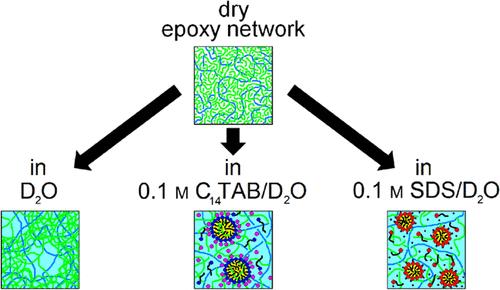离子表面活性剂与环氧基水凝胶相互作用的SANS研究
IF 3.9
2区 化学
Q2 CHEMISTRY, MULTIDISCIPLINARY
引用次数: 0
摘要
采用重量法和小角中子散射(SANS)相结合的方法研究了两种离子表面活性剂对环氧两亲性聚合物网络(APN)膨胀所得水凝胶组成和结构的影响。以端二氨基二氧基聚丙烯(POP)和聚氧乙烯(POE)为原料,合成了化学计量型环氧APN。在重水中采用阳离子(肉豆浆三甲溴化铵(C14TAB))或阴离子(十二烷基硫酸钠(SDS))表面活性剂的亚、超临界溶液制备水凝胶。在超临界浓度下,SDS对水凝胶的组成和结构的影响比C14TAB强得多。利用percusu - yevick硬球(HS)模型和重标平均球近似(RMSA)模型对实验SANS曲线进行了综合分析和拟合,得到了水凝胶结构的细节。前一种模型适用于在低浓度表面活性剂溶液中制备的水凝胶,其平均半径约为39-45 Å的球形结构域是由高度膨胀的网络分散在与结合的烷基表面活性剂尾部混合的低膨胀网络的基质中。在后一种模型中,在足够高浓度的表面活性剂溶液中制备的水凝胶由分散在高度膨胀网络的基质中的表面活性剂胶束组成。水凝胶中形成的C14TAB胶束和SDS胶束的平均半径分别约为0.28和17 Å。表面活性剂尾部与POP链的强结合以及水凝胶内部大量高流动性反离子的拖拽是观察到的效果的原因。本研究提供了聚合物水凝胶内部表面活性剂组织的重要信息,对聚合物水凝胶的应用具有重要意义。本文章由计算机程序翻译,如有差异,请以英文原文为准。

Investigation of the Interaction of Ionic Surfactants with Epoxy-Based Hydrogels by SANS
We investigated the effect of two ionic surfactants on the composition and structure of hydrogels obtained by swelling an epoxy amphiphilic polymer network (APN) using a combination of gravimetry and small-angle neutron scattering (SANS). Stoichiometric epoxy APN was synthesized by the reaction of diamino and diepoxy-terminated polypropylene (POP) and polyoxyethylene (POE). Sub- and supercritical solutions of surfactants with either cationic (myristyltrimethylammonium bromide (C14TAB)) or anionic (sodium dodecyl sulfate (SDS)) headgroups in heavy water were used in the preparation of the hydrogels. At supercritical concentrations, SDS exhibited a much stronger effect on the composition and structure of the hydrogels than C14TAB. The details of the hydrogel structure were deduced by general analysis and fitting of the experimental SANS profiles to two model scattering functions exploiting the Percus–Yevick hard-sphere (HS) model and rescaled mean spherical approximation (RMSA), respectively. In the former model, valid for the hydrogels prepared in low concentrated surfactant solutions, spherical domains of average radius of ca. 39–45 Å from a highly swollen network dispersed in a matrix of a poorly swollen network mixed with the bound alkyl surfactant tails were revealed. In the latter model, hydrogels prepared in surfactant solutions of sufficiently high concentrations consist of surfactant micelles dispersed in a matrix of a highly swollen network. The average radii of the C14TAB and SDS micelles formed in the hydrogels were ca. 28 and 17 Å, respectively. The strong binding of surfactant tails with POP chains and dragging of large amounts of highly mobile counterions inside the hydrogels were responsible for the effects observed. This study provides important information about the surfactant organization inside polymer hydrogels, which is important for their applications.
求助全文
通过发布文献求助,成功后即可免费获取论文全文。
去求助
来源期刊

Langmuir
化学-材料科学:综合
CiteScore
6.50
自引率
10.30%
发文量
1464
审稿时长
2.1 months
期刊介绍:
Langmuir is an interdisciplinary journal publishing articles in the following subject categories:
Colloids: surfactants and self-assembly, dispersions, emulsions, foams
Interfaces: adsorption, reactions, films, forces
Biological Interfaces: biocolloids, biomolecular and biomimetic materials
Materials: nano- and mesostructured materials, polymers, gels, liquid crystals
Electrochemistry: interfacial charge transfer, charge transport, electrocatalysis, electrokinetic phenomena, bioelectrochemistry
Devices and Applications: sensors, fluidics, patterning, catalysis, photonic crystals
However, when high-impact, original work is submitted that does not fit within the above categories, decisions to accept or decline such papers will be based on one criteria: What Would Irving Do?
Langmuir ranks #2 in citations out of 136 journals in the category of Physical Chemistry with 113,157 total citations. The journal received an Impact Factor of 4.384*.
This journal is also indexed in the categories of Materials Science (ranked #1) and Multidisciplinary Chemistry (ranked #5).
 求助内容:
求助内容: 应助结果提醒方式:
应助结果提醒方式:


